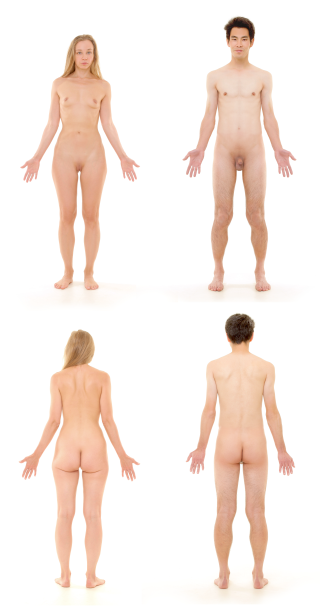
The human body is the entire structure of a human being. It is composed of many different types of cells that together create tissues and subsequently organs and then organ systems. They ensure homeostasis and the viability of the human body.

The circulatory system is a system of organs that includes the heart, blood vessels, and blood which is circulated throughout the entire body of a human or other vertebrate. It includes the cardiovascular system, or vascular system, that consists of the heart and blood vessels. The circulatory system has two divisions, a systemic circulation or circuit, and a pulmonary circulation or circuit. Some sources use the terms cardiovascular system and vascular system interchangeably with circulatory system.
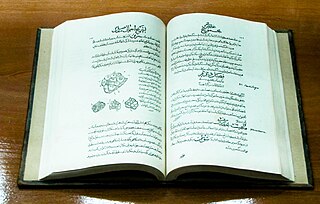
The Canon of Medicine is an encyclopedia of medicine in five books compiled by Muslim Persian physician-philosopher Avicenna and completed in 1025. It is among the most influential works of its time. It presents an overview of the contemporary medical knowledge of the Islamic world, which had been influenced by earlier traditions including Greco-Roman medicine, Persian medicine, Chinese medicine and Indian medicine. Its translation from Arabic to Latin in 12th century Toledo greatly influenced the development of medieval medicine. It became the standard textbook for teaching in European universities into the early modern period.
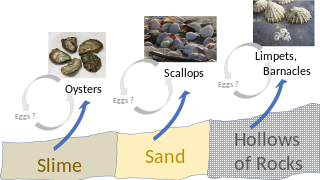
Spontaneous generation is a superseded scientific theory that held that living creatures could arise from nonliving matter and that such processes were commonplace and regular. It was hypothesized that certain forms, such as fleas, could arise from inanimate matter such as dust, or that maggots could arise from dead flesh. The doctrine of spontaneous generation was coherently synthesized by the Greek philosopher and naturalist Aristotle, who compiled and expanded the work of earlier natural philosophers and the various ancient explanations for the appearance of organisms. Spontaneous generation was taken as scientific fact for two millennia. Though challenged in the 17th and 18th centuries by the experiments of the Italian biologists Francesco Redi and Lazzaro Spallanzani, it was not discredited until the work of the French chemist Louis Pasteur and the Irish physicist John Tyndall in the mid-19th century.

Embryology is the branch of animal biology that studies the prenatal development of gametes, fertilization, and development of embryos and fetuses. Additionally, embryology encompasses the study of congenital disorders that occur before birth, known as teratology.
In yoga, Ayurveda, and Indian martial arts, prana permeates reality on all levels including inanimate objects. In Hindu literature, prāṇa is sometimes described as originating from the Sun and connecting the elements.

Erasistratus was a Greek anatomist and royal physician under Seleucus I Nicator of Syria. Along with fellow physician Herophilus, he founded a school of anatomy in Alexandria, where they carried out anatomical research. As well, he is credited with helping to found the methodic school of teachings of medicine in Alexandria whilst opposing traditional humoral theories of Hippocratic ideologies. Together with Herophilus, he is credited by historians as the potential founder of neuroscience due to his acknowledgements of nerves and their roles in motor control through the brain and skeletal muscles.
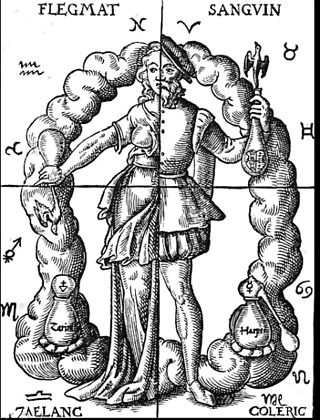
Humorism, the humoral theory, or humoralism, was a system of medicine detailing a supposed makeup and workings of the human body, adopted by Ancient Greek and Roman physicians and philosophers.

The pulmonary circulation is a division of the circulatory system in all vertebrates. The circuit begins with deoxygenated blood returned from the body to the right atrium of the heart where it is pumped out from the right ventricle to the lungs. In the lungs the blood is oxygenated and returned to the left atrium to complete the circuit.
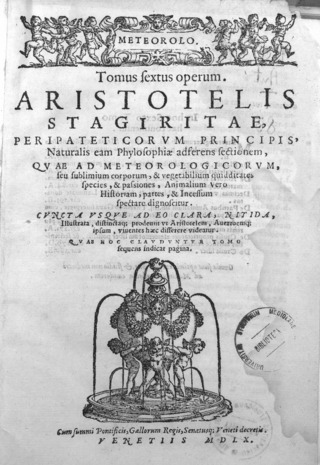
Meteorology is a treatise by Aristotle. The text discusses what Aristotle believed to have been all the affections common to air and water, and the kinds and parts of the Earth and the affections of its parts. It includes early accounts of water evaporation, earthquakes, and other weather phenomena.
The Generation of Animals is one of the biological works of the Corpus Aristotelicum, the collection of texts traditionally attributed to Aristotle. The work provides an account of animal reproduction, gestation and heredity.
Praxagoras was a figure of medicine in ancient Greece. He was born on the Greek island of Kos in about 340 BC. Both his father, Nicarchus, and his grandfather were physicians. Very little is known of Praxagoras' personal life, and none of his writings have survived.
A biological system is a complex network which connects several biologically relevant entities. Biological organization spans several scales and are determined based different structures depending on what the system is. Examples of biological systems at the macro scale are populations of organisms. On the organ and tissue scale in mammals and other animals, examples include the circulatory system, the respiratory system, and the nervous system. On the micro to the nanoscopic scale, examples of biological systems are cells, organelles, macromolecular complexes and regulatory pathways. A biological system is not to be confused with a living system, such as a living organism.
On Youth, Old Age, Life and Death, and Respiration is one of the short treatises that make up Aristotle's Parva Naturalia.

Semen, also known as seminal fluid, is an organic bodily fluid that contains spermatozoa. Spermatozoa are secreted by the male gonads and other sexual organs of male or hermaphroditic animals and can fertilize the female ovum. Semen is produced and originates from the seminal vesicle, which is located in the pelvis. The process that results in the discharge of semen from the urethral orifice is called ejaculation. In humans, seminal fluid contains several components besides spermatozoa: proteolytic and other enzymes as well as fructose are elements of seminal fluid which promote the survival of spermatozoa and provide a medium through which they can move or "swim". The fluid is adapted to be discharged deep into the vagina, so the spermatozoa can pass into the uterus and form a zygote with an egg.
Pneuma is an ancient Greek word for "breath", and in a religious context for "spirit" or "soul". It has various technical meanings for medical writers and philosophers of classical antiquity, particularly in regard to physiology, and is also used in Greek translations of ruachרוח in the Hebrew Bible, and in the Greek New Testament.
The Garbha Upanishad, or Garbhopanishad, is one of the minor Upanishads, listed number 17 in the modern anthology of 108 Hindu Upanishadic texts. Written in Sanskrit, it is associated with the Krishna Yajurveda by some, and as a Vedantic Upanishad associated with the Atharvaveda by other scholars. It is considered one of the 35 Samanya (general) Upanishads. The last verse of the Upanishad attributes the text to sage Pippalada, but the chronology and author of the text is unclear, and the surviving manuscripts are damaged, inconsistent with each other and incomplete.
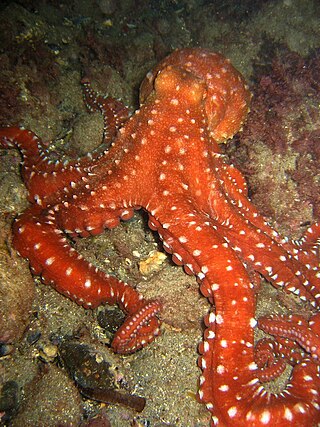
Aristotle's biology is the theory of biology, grounded in systematic observation and collection of data, mainly zoological, embodied in Aristotle's books on the science. Many of his observations were made during his stay on the island of Lesbos, including especially his descriptions of the marine biology of the Pyrrha lagoon, now the Gulf of Kalloni. His theory is based on his concept of form, which derives from but is markedly unlike Plato's theory of Forms.

The search for a hypothetical soul and its location have been a subject of much speculation throughout history. In early medicine and anatomy, the location of the soul was hypothesized to be located within the body. Aristotle and Plato understood the soul as a corporeal form but closely related to the physical world. The Hippocratic Corpus chronicles the evolution of thought that the soul is located within the body and is manifested in diseased conditions. Later, Galen explicitly used Plato's description of the corporeal soul to physical locations in the body. The logical (λογιστικός) in the brain, the spirited (θυμοειδές) in the heart, and the appetitive (ἐπιθυμητικόν) in the liver. Da Vinci had a similar approach to Galen, locating the soul, or senso comune, as well as the imprensiva (intellect) and memoria (memory) in different ventricles of the brain. Today neuroscientists and other fields of science that deal with the body and the mind, such as psychology, bridge the gap between what is physical and what is corporeal.
According to the cardiocentric hypothesis, the heart has a profound influence on human emotions, cognition, and awareness. This notion may be traced back to ancient civilizations such as Egypt and Greece, where the heart was regarded not only as a physical organ but also as a repository of emotions and wisdom. Aristotle, a well-known Greek philosopher in this field, contributed to the notion by thinking the heart to be the centre of both emotions and intellect. He believed that the heart was the center of the psycho-physiological system and that it was responsible for controlling sensation, thought, and body movement. He also observed that the heart was the origin of the veins in the body and that the existence of pneuma in the heart was to function as a messenger, traveling through blood vessels to produce sensation. This point of view remained throughout history, spanning the Middle Ages and Renaissance, influencing medical and intellectual debate.














